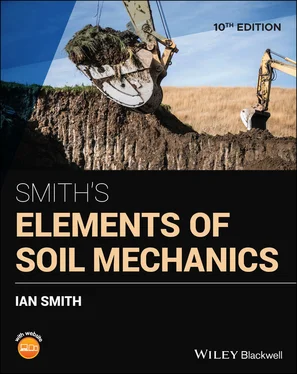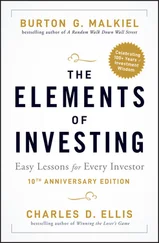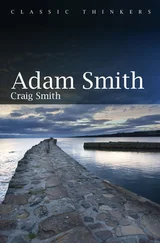12 Chapter 12Fig. 12.1 Compressive deformation. (a) Immediate settlement. (b) Consolidati...Fig. 12.2 Immediate settlement of thin clay layer. (a) Thin clay layer (H < ...Fig. 12.3 Example 12.2. (a) The problem. (b) Area split into rectangles.Fig. 12.4 Variation of I zwith depth.Fig. 12.5 Part (a): (a) N to z relationship; (b) chosen layers.Fig. 12.6 Part (b): (a) C rto z relationship; (b) variation of I z.Fig. 12.7 The consolidation test. (a) Consolidation apparatus. (b) Typical t...Fig. 12.8 Void ratio to effective pressure curves. (a) Typical e–p curve. (b...Fig. 12.9 Example 12.4. (a) e‐p plot. (b) H‐p plot.Fig. 12.10 e–p and e–log p curves for natural consolidation and for a normal...Fig. 12.11 Compression curves for an overconsolidated clay. (a) Graphical de...Fig. 12.12 Example 12.6. (a) Foundation plan. (b) Triaxial results.Fig. 12.13 Example 12.7. (a) Plan of foundation. (b) Subsoil conditions.Fig. 12.14 Stress paths in the consolidation test.Fig. 12.15 Effective stress path for the general consolidation of a normally...Fig. 12.16 Example 12.9.
13 Chapter 13Fig. 13.1 Analogy of consolidation settlement.Fig. 13.2 Forms of initial excess pore pressure. (a) Uniform. (b) Triangular...Fig. 13.3 Variation of excess pore pressure with depth and time.Fig. 13.4 Theoretical consolidation curves.Fig. 13.5 Drainage path length. (a) Two‐way drainage. (b) One‐way drainage....Fig. 13.6 Typical consolidation test results.Fig. 13.7 The square root of time ‘fitting’ method. (a) Theoretical curve. (...Fig. 13.8 Example 13.1.Fig. 13.9 Consolidation during construction.Fig. 13.10 Example 13.4.Fig. 13.11 Taylor's series.Fig. 13.12 Explicit recurrence formula (general). (a) Consolidation grid. (b...Fig. 13.13 Explicit recurrence formula: treatment for an impermeable boundar...Fig. 13.14 Example 13.5.Fig. 13.15 Example 13.6. (a) Initial distribution (kPa). (b) Numerical itera...Fig. 13.16 Schematic form of the finite difference equation (two‐dimensional...Fig. 13.17 Schematic form of the finite difference equation (three‐dimension...Fig. 13.18 Typical prefabricated vertical drains arrangements.Fig. 13.19 Popular arrangements of prefabricated vertical drains. (a) Square...Fig. 13.20 Coordinate directions.Fig. 13.21 Equivalent radius: triangular system.Fig. 13.22 Radial consolidation rates (after Barron, 1948).
14 Chapter 14Fig. 14.1 Forces involved in a slope of granular material.Fig. 14.2 Seepage due to rapid drawdown.Fig. 14.3 Flow net when flow is parallel and at the surface.Fig. 14.4 Planar translational slip.Fig. 14.5 Typical rotational slip in a cohesive soil.Fig. 14.6 Example of two possible slip surfaces.Fig. 14.7 Types of slip failures. (a) Toe failure. (b) Circle tangential to ...Fig. 14.8 Total stress analysis.Fig. 14.9 Tension crack in a cohesive soil.Fig. 14.10 Example 14.2.Fig. 14.11 The Swedish method of slices.Fig. 14.12 The problem.Fig. 14.13 Choice of slices.Fig. 14.14 Effect of tension crack.Fig. 14.15 Example 14.4.Fig. 14.16 Example 14.4.Fig. 14.17 Example 14.5.Fig. 14.18 Choice of slices – ensure base of each slice is only in one soil....Fig. 14.19 Determination of excess head at a point on a flow net.Fig. 14.20 Upstream dam face subjected to sudden drawdown.Fig. 14.21 Effective stress analysis: forces acting on a vertical slice.Fig. 14.22 Example 14.6.Fig. 14.23 Choice of slices.Fig. 14.24 Example spreadsheet template for slope stability calculation.Fig. 14.25 Example 14.7.Fig. 14.26 Flow net and choice of slices.Fig. 14.27 Spreadsheet solutions.Fig. 14.28 Example 14.8.Fig. 14.29 Calculations for each value of r u.Fig. 14.30 Variation of F with r u.Fig. 14.31 Taylor’s curves for rapid assessment of F. (For ϕ = 0° and Fig. 14.32 Effect of depth limitation on Taylor’s curves (for β < 53° a...Fig. 14.33 Sliding block or wedge failure.Fig. 14.34 Example 14.11: (a) Cross-section of dam. (b) Wedge forces. (c) Po...Fig. 14.35 Example 14.14: conventional method.Fig. 14.36 Example 14.14: rigorous method.Fig. 14.37 Exercise 14.1.Fig. 14.38 Exercise 14.2.Fig. 14.39 Exercise 14.5.Fig. 14.40 Exercise 14.6.Fig. 14.41 Exercise 14.7.Fig. 14.42 Exercise 14.9.
15 Chapter 15Fig. 15.1 Equipment for the 2.5 kg rammer compaction test.Fig. 15.2 The vibrating hammer compaction test.Fig. 15.3 Typical compaction test results.Fig. 15.4 Example 15.1.Fig. 15.5 Overcompaction.Fig. 15.6 Core cutter for clay soil.Fig. 15.7 Sand replacement method.Fig. 15.8 Time domain reflectometry probe.Fig. 15.9 Flexible pavement construction.Fig. 15.10 The California bearing ratio test.Fig. 15.11 Typical CBR results.Fig. 15.12 Example 15.4.Fig. 15.13 The moisture content apparatus.Fig. 15.14 Example 15.5.Fig. 15.15 Typical MCV calibration line.Fig. 15.16 Typical calibration line for different soils.
16 Chapter 16Fig. 16.1 Typical stress–strain curve of a uniaxial test.Fig. 16.2 Examples of constitutive models to describe the stress–strain beha...Fig. 16.3 Load-settlement curve of a rigid shallow foundation subjected to a...Fig. 16.4 Hooke’s law application.Fig. 16.5 Elastic behaviour of a wire for a finite range of applied loads.Fig. 16.6 Stress-strain behaviour of an elastic material.Fig. 16.7 Material constants defining an elastic behaviour.Fig. 16.8 A material subjected to normal and tangential stresses in three di...Fig. 16.9 Behaviour of a rigid circular footing on dense sand: experimental ...Fig. 16.10 Examples to indicate the limitations of Hooke’s law for elastic b...Fig. 16.11 Non-linear stress–strain behaviour.Fig. 16.12 Tangent and secant modulus of a nonlinear elastic model.Fig. 16.13 Rigid plastic model.Fig. 16.14 Yield surface.Fig. 16.15 Plastic loading and unloading.Fig. 16.16 Tresca and Von Mises yield criteria.Fig. 16.17 Von Mises yield criterion in principal stress space.Fig. 16.18 Drucker–Prager yield criterion in principal stress space.Fig. 16.19 Mohr–Coulomb failure criterion.Fig. 16.20 Mohr–Coulomb criterion in principal stress space.Fig. 16.21 Stress–strain curve showing: different strain states for a given ...Fig. 16.22 Plastic strain increment.Fig. 16.23 Non-associated Mohr–Coulomb flow rule.Fig. 16.24 Mohr–Coulomb elastic-perfectly plastic model.Fig. 16.25 Typical stress-strain curve with pre-peak hardening and post-peak...Fig. 16.26 Stress–strain curve with a hardening rule.Fig. 16.27 Stress–strain curve with softening.Fig. 16.28 Hardening types: (a) isotropic hardening, (b) kinematic hardening...Fig. 16.29 Isotropic hardening.Fig. 16.30 Bauschinger effect.Fig. 16.31 Kinematic hardening.Fig. 16.32 Uniaxial stress-strain curve with hardening.
1 Cover Page
2 Title Page
3 Copyright Page
4 Preface
5 About the Author
6 Notation Index
7 About the Companion Website
8 Table of Contents
9 Begin Reading
10 References
11 Index
12 Wiley End User License Agreement
1 iii
2 iv
3 xi
4 xii
5 xiii
6 xiv
7 xv
8 xvi
9 xvii
10 xviii
11 xix
12 xx
13 1
14 3
15 4
16 5
17 6
18 7
19 8
20 9
21 10
22 11
23 12
24 13
25 14
26 15
27 16
28 17
29 18
30 19
31 20
32 21
33 22
34 23
35 24
36 25
37 26
38 27
39 28
40 29
41 30
42 31
43 32
44 33
45 34
46 35
47 36
48 37
49 38
50 39
51 41
52 42
53 43
54 44
55 45
56 46
57 47
58 48
59 49
60 50
61 51
62 52
63 53
64 54
65 55
66 56
67 57
68 58
69 59
70 60
71 61
72 62
73 63
74 64
75 65
76 66
77 67
78 68
79 69
80 70
81 71
82 72
Читать дальше












